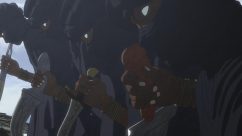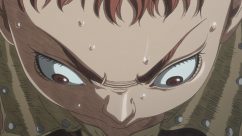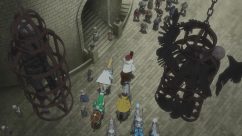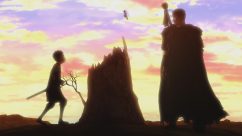Episode 5 Starts off with Isidro, and some half-assed attempt at levity. This is really harmless, but it highlights an issue that has become apparent from the first episode. It’s widely understood that the inclusion of Puck was done to bring some light-heartedness to an otherwise grim story. But yet again this proves the point that manga and anime are widely different mediums, and what works in one doesn’t necessarily work in the other. A manga is a very fluid format. The style and design elements can be altered to communicate different concepts. It is not at all uncommon to have characters portrayed in chibi or exaggerated forms to correspond to the situation. They can also include footnotes and other remarks to clarify and explain certain things. These techniques can’t really be done the same way in an anime adaptation, or when attempted could seriously backfire. The medium of motion pictures revolves quite extensively around immersion, and things that can hinder that immersion are best to not be included in the first place. This is not to say that the combination of serious subject matter and comedy can’t be achieved, for example, Cowboy Bebop, Black Lagoon, Welcome to NHK and Kemonozume have all done this to varying degrees, but doing so requires a mindful approach and a delicate touch.
Thankfully the farce is soon interrupted by the Kushan hunters. Here we get another action scene, which similar to the ones up to now was just alright. There are some interesting angles and framing, but the quick cuts in editing and the unnecessary rotation take away from the action. This is exacerbated by the drops in the frame-rate. I researched the reason for this back during the first season of Knights of Sidonia, and apparently this is due to the cel shading that is done on top of the CGI. In these types of animations when the camera pans the animators need to draw in the details in almost every frame, causing the process to become seriously long and costly. The solution they came up with was to limit the number of frames, so the required number of overlay shading could be reduced. My question is that knowing their limitations, why do they include so many panning shots that aren’t even really necessary? Well the upside of the action scene is that we get to yet again hear Hirasawa’s excellent track Hai yo (Oh Ashes). I instantly light up every time the track kicks in and the pipes swell up. He truly understands Berserk, and given his close friendship with Miura, it is not at all surprising. I only wish that he had composed the entirety of the OST.
Next we get the reintroduction of Silat and his Bakiraka clansmen. If I’m not mistaken this is the first time since the movies that he has made an appearance. Silat is an interesting case, since he’s one of the handful of characters to endure in the story past the Golden Age Arc, and although he continues to play a part he is still usually delegated to the sidelines. He was understandably removed from the 97’ adaptation, as there was no reason to include him so briefly at the end of the series. He also made an appearance in the movie trilogy in a slick action scene, but the third film failed to correctly portray the complexity of his character. We will see how much they will develop him in the new show.
I want to point out how newcomer unfriendly this adaptation truly is. To those who have only gotten into Berserk with this new series Silat won’t be making any sense. A lot of other factors are exactly the same, with them only resonating with fans of the manga or the previous iterations. Liden Films have failed to properly communicate that this is a continuation of the movies, and yes, this is linked to the movies and not the old show, as there are flashback scenes that include segments and music directly taken from the trilogy. This might be due to some licensing issues with Studio 4°C who made the films. I am personally fine with this, as I am very familiar with the material, and the last thing I wanted was for yet another developer to go over the Golden Age Arc. I still can see a lot of new viewers passing on this show due to their confusion, and it would be a shame for people to avoid the Berserk franchise only due to this series’ lack of quality; which is the most damaging aspect of this adaptation.
The next section switches back to Albion, as we get to see Mozguz engaging in an uncharacteristic act of kindness. It doesn’t take long for the audience to be reassured of his depravity, as he moves on to torturing the mother of the child he just saved. I’m not really a fan of these sudden outbursts which are accompanied by severe character deformation. I understand that they suppose to be somewhat shocking, and aim at creating tension in the scene, but they are often just distracting. This brings to my mind a certain scene at the end of the first episode of Akame ga Kill, which has a little girl suddenly exposing her messed up nature. In fairness this isn’t as abrupt as in AgK, since Mozguz is already shown to be vile and ruthless. What I admire here is the daringness of the series, which doesn’t shy away from sex and violence. They have included things that I was certain will be dropped, so the producers are at least adamant on keeping the dark edgy side of Berserk. However I do realize that this might be done more for the sake of publicity, and not purely out of artistic integrity. I wish that the same approach was applied to the more subtle tone and subtext of the Berserk story.
Speaking of daringness, we get the return of the nippleless women, this time in the form of Luca. They should either go all the way with it or not include nudity at all, but I guess there are restrictions that are out of their control. Some suggest that these would be fixed in the Bluray release, but considering that they have to go over and draw it in every frame causes me to doubt that. We get to see a scene with Luca entertaining Jermore, a minor member of the Holy Iron Chain Knights. Luca is an interesting character, and despite being a prostitute she is still portrayed as a strong woman, who not only knows how to take care of herself but also the rest of her camp. It’s good to see a working lady portrayed in a sympathetic light, and she manages the group with almost a socialist methodology. There is also a brief exploration of wartime economics and upheavals. The kingdom of Midland doesn’t seem to catch a break, with the Kushan invasion happening on the heels of the recent conclusion of the hundred year war with the Chuder Empire. The passing of the king has only added to the social instability, and this can be seen by the ubiquity of famine and poverty. For most people hope seems to have faded, and they all do whatever it takes just to survive. The stoning scene shows how ruthless people have become. Being from the Middle East myself, I know how average people can act in horrific ways. When individuals are themselves under pressure they find catharsis in having any sense of control. It is probably not by chance that such crisis has consumed the land, setting up the stage for a certain someone to make his return. There is also a brief introduction of the rest of Luca’s group, but Nina is really the only one of any importance. We get to see her plight, and it’s implied that syphilis is now commonplace.
The episode ends with a scene between Guts and Isidro. Despite being a goofy little brat, it’s clear that Guts sees a bit of himself in the kid, persuading him to let Isidro stick around. After the so-called “epihpany” at Godo’s house it appears that Guts has calmed down a little bit, causing him to warm up and let go of his constant rage. It’s interesting to see how close they’ve been following the manga in the recent episodes. Looks like the sporadic script of the first few ones might’ve been growing pains, and they have now found their groove, and are now simply attempting to tell the story. The next episode is “A Nighttime Feast: Burning at the Stake” implying that it might be multi-episode chapter. I’m getting the sense that we might be getting the ‘cave scene’ after all. The majestic Skull Knight is also making his reappearance. Berserk 2016 has serious issues, no doubt, but I would be lying if I’d said that I’m not enjoying myself to some extent. It is a treat to get a new Berserk at the end of the week, and unfortunately when anticipation rises the wait for the next episode only grows longer.
~Bam~








